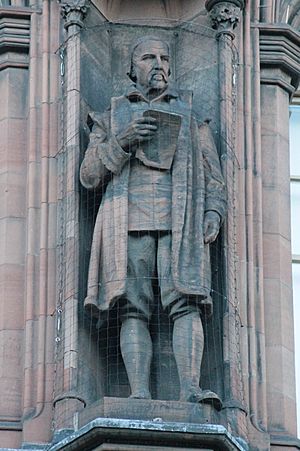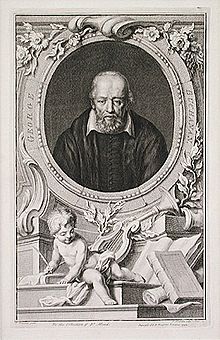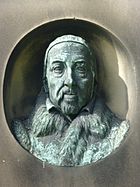George Buchanan facts for kids
Quick facts for kids
George Buchanan
|
|
|---|---|

George Buchanan by A Bronckorst, 1581 (National Gallery of Scotland).
|
|
| Born | February 1506 Killearn, Stirlingshire, Scotland
|
| Died | 28 September 1582 (aged 76) Edinburgh, Scotland
|
| Nationality | Scottish |
| Alma mater | University of St Andrews (B.A.) University of Paris (M.A.) |
| Occupation | historian, scholar |
George Buchanan (Scottish Gaelic: Seòras Bochanan; February 1506 – 28 September 1582) was a very important Scottish historian and scholar. He lived during the time of the Renaissance, a period of great learning. Many people believe Buchanan was the smartest person in Scotland during the 1500s.
His ideas about how people could stand up to kings who abused their power became very popular. This was especially true during the Scottish Reformation, a time of big changes in religion. Historians say that Buchanan's ideas were so strong that they helped lead to King James VII being removed from power in 1689.
In 1579, Buchanan published a book called De Jure Regni apud Scotos. In this book, he wrote that all political power comes from the people. He also said that a king must follow the rules set when he first took power. If a king acts like a tyrant (a cruel ruler), people have the right to resist him. They can even punish him.
The importance of Buchanan's writings is clear because they were banned after he died. In 1584, an act of parliament (a law made by the government) condemned his work. His books were even burned by the University of Oxford in 1664 and 1683.
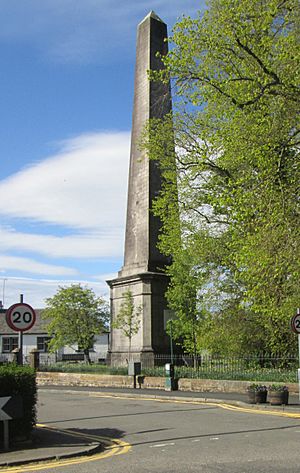
Contents
Who Was George Buchanan?
George Buchanan was a brilliant Scottish scholar and writer. He lived during a time of big changes in Europe, including new ways of thinking and religious reforms. He is remembered for his strong beliefs about how rulers should govern and the rights of the people.
His Early Life and Education
George Buchanan was born in February 1506 in a small farming area called Moss, near Killearn, Scotland. His father died young, leaving his mother, five sons, and three daughters in poverty. George's mother, Agnes Heriot, came from a well-known family. George spoke Scottish Gaelic as his first language.
In 1520, his uncle, James Heriot, helped him go to the University of Paris. There, George learned about two major movements of his time: the Renaissance and the Reformation. He spent his time writing poems, which was a common task for students then.
Returning to Scotland
In 1522, his uncle passed away, and George became very sick. He had to leave Paris and return to Scotland. After he got better, he joined some French soldiers and took part in a failed attack on Wark Castle in 1523.
The next year, he went to the University of St Andrews. He earned his first degree there in 1525. He mainly went to listen to the lectures of a philosopher named John Mair. When Mair moved to Paris, Buchanan followed him in 1526.
Becoming a Professor
In 1528, Buchanan earned his Master's degree at the Scots College in Paris. The next year, he became a professor at the College of Sainte-Barbe. He taught there for over three years. Sainte-Barbe was a very respected college. George helped make it even better by introducing new ways to teach Latin.
He was also elected "Procurator of the German Nation" at the University of Paris. This was an important student leadership role. He was re-elected four times in a row! In 1531, he stopped being a professor. In 1532, he became a tutor to a young nobleman, Gilbert Kennedy, 3rd Earl of Cassilis. He returned to Scotland with him in 1537.
His Religious Views
At first, Buchanan had similar views to Erasmus about the Roman Catholic Church. He didn't reject its beliefs, but he felt free to criticize how it acted. Even though he listened to the ideas of the Protestant Reformers, he didn't officially join them until 1553.
His first major writing in Scotland was a poem called Somnium. It was a funny attack on the Franciscan friars (a group of monks) and their way of life. King James V liked this attack on the monks. He even hired Buchanan to tutor one of his sons. Buchanan wrote more poems that criticized the monks, which made the Franciscan order dislike him very much.
Life in Exile
Arrest and Escape
In 1539, Protestants were being persecuted in Scotland. Buchanan was arrested along with others. Even though the King had stopped protecting him, Buchanan managed to escape. He fled to London, then to Paris.
However, in Paris, he was in danger again because his enemy, Cardinal David Beaton, arrived there. So, Buchanan moved to Bordeaux after being invited by André de Gouveia. Gouveia was the head of a new school called the College of Guienne. He helped Buchanan get a job as a Latin professor there.
Important Works in Bordeaux
While in Bordeaux, Buchanan finished several important works. These included his translations of the Greek plays Medea and Alcestis. He also completed two of his own plays, Jephthes, sive Votum and Baptistes (sive Calumnia).
Michel de Montaigne, a famous writer, was one of Buchanan's students in Bordeaux. Montaigne even acted in Buchanan's plays. Montaigne later called Buchanan one of the best Latin poets of his time. Buchanan also became good friends with Julius Caesar Scaliger, another famous scholar.
Return to Paris and Coimbra
Around 1542 or 1543, Buchanan went back to Paris. In 1544, he became a professor at the Collège du cardinal Lemoine.
In 1547, Buchanan joined a group of French and Portuguese scholars. They were invited by Gouveia to teach at the University of Coimbra in Portugal. This university was very successful at the time.
Trial and Imprisonment
However, trouble soon started. In October 1549, an investigation began. Buchanan and two Portuguese colleagues were put on trial. Buchanan was accused of having Lutheran (Protestant) and Jewish beliefs. He defended himself, admitting some of the charges were true.
Around June 1551, he was sentenced to give up his "errors" and be imprisoned. He was sent to the monastery of São Bento in Lisbon. He said the monks there were "not unkind but ignorant." While imprisoned, he started translating the Psalms (songs from the Bible) into Latin poetry. He finished most of this work there.
Release and Return to France
After seven months, Buchanan was released. He was told to stay in Lisbon, but this rule was lifted in February 1552. Buchanan then sailed to England, but soon went back to Paris. In 1553, he became a professor again at the College of Boncourt.
He stayed there for two years. Then, he became a tutor to the son of a French military leader, the Maréchal de Brissac. It was during this time in France, where Protestants were being punished, that Buchanan decided to fully support Calvinism, a branch of Protestantism.
Back in Scotland
Becoming a Protestant
Around 1560 or 1561, Buchanan returned to Scotland. By April 1562, he was tutoring the young Mary, Queen of Scots. He read history books with her every day. Even though he had criticized the Catholic Church, he had remained Catholic himself. But now, he openly joined the Protestants and their Reformed Church.
In 1566, he became the head of St Leonard's College at St Andrews University. The Earl of Moray appointed him to this role. Two years before, the Queen had given him money from Crossraguel Abbey. Even though he was not a priest, he was chosen as the leader of the Church of Scotland's main meeting, the General Assembly, in 1567. He was the last non-clergyman to be chosen for this role until 2004.
Tutor to a King
Buchanan went with the Regent Moray (who was ruling Scotland for the young Queen) to England. There, Buchanan wrote a famous work called Detectio Mariæ Reginæ. This book criticized Queen Mary's actions concerning her husband, Henry Darnley, and his death.
In 1570, after Moray was killed, Buchanan became one of the main teachers for the young King James VI. Buchanan was a strict teacher. He even used to hit James to make him learn! But he also taught James to love books and learning for his whole life. Buchanan wanted James to be a good, Protestant king who understood that a king's power had limits. He wrote about these limits in his book De Jure Regni apud Scotos.
While tutoring the King, Buchanan also held other important jobs. He was briefly in charge of the government's records. Then, he became the Keeper of the Privy Seal of Scotland. This job allowed him to have a seat in the Scottish parliament. He kept this job for several years, at least until 1579.
His Final Years
In his last years, Buchanan worked on finishing and publishing his two most important books: De Jure Regni apud Scotos (1579) and Rerum Scoticarum Historia (1582).
He died in his home in Edinburgh on September 28, 1582. He was buried the next day in Greyfriars Kirkyard. Today, two memorials in the graveyard claim to mark his burial spot. The smaller, newer one is the correct one.
His Writings
A Master of Latin
George Buchanan was incredibly skilled at writing in Latin. Many people say he was one of the best Latin writers of his time. He wrote Latin so well that it seemed like his native language. He also had a great talent for poetry and original ideas. His translations of the Psalms and Greek plays were more than just copies; they were works of art. His two plays, Baptistes and Jephthes, were famous throughout Europe for their academic quality.
Important Prose Works
Besides his plays and poems, Buchanan wrote other works. These include:
- Chamaeleon: A funny attack written in Scots against a politician named Maitland of Lethington.
- A Latin translation of a grammar book by Thomas Linacre.
- Libellus de Prosodia: A book about how words are pronounced.
- Vita ab ipso scripta biennio ante mortem: His own life story, written two years before he died.
He also wrote De Sphaera, a five-book poem that discussed the Ptolemaic theory of the universe. This theory said that the Earth was the center of the universe, which was different from the new ideas of Nicolaus Copernicus who said the sun was the center.
His Lasting Legacy
Buchanan's influence on later writers was huge. His ideas and writing style continued to inspire people for many years. For example, in 1726, a famous bookseller in London named Andrew Millar named his shop 'Buchanan's Head'. The shop sign showed George Buchanan's face, showing how well-known and respected he was in Scottish literature.
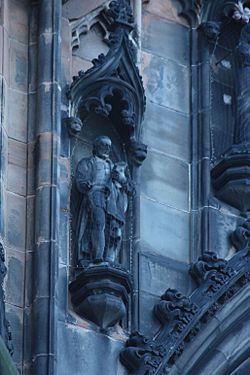
Memorials
- A statue of Buchanan can be found on the west side of the Scott Monument in Edinburgh. It was made by John Rhind.
- There is a memorial stained glass window in the south wall of Greyfriars Kirk.
- A statue of Buchanan is in the Hall of Heroes at the National Wallace Monument in Stirling.
- A monument was built in his birthplace, Killearn, Stirlingshire, in 1789. People donated money to build it.
Images for kids
See also
 In Spanish: George Buchanan para niños
In Spanish: George Buchanan para niños
- Scottish literature
- British Latin Literature


